Some companies have embraced the remote working environment brought on by the pandemic, while others are urging their employees to flock back to their expensive offices again. But how does this impact employee happiness?
Our large-scale study of 12,455 respondents has the answers:
- The ability to work remotely increases employee happiness by as much as 20%.
- Millennials are happiest when working remotely.
- Returning to office-based work after the pandemic reduces employee happiness.
- Employee happiness decreases as commute times increase.
- Happiness at work is significantly correlated to overall life happiness.
These observations, and many more, are covered in this in-depth analysis of our study.
The ability to work remotely increases employee happiness
We asked our respondents the following question:
- If you look at your work, how would you rate your happiness on a scale from 1 to 10?
This resulted in the following answers:

The average happiness at work of all respondents was 6.44 on a scale from 1 to 10.
We then asked them about how much of their time is spent working from home (or remotely). This resulted in the following answers.

On average, our respondents spend 45% of their time working remotely.
Respondents were instructed to calculate a percentage based on a full work week. For example, if you work 8 hours per 40-hour work week remotely, then the answer should be 20%. If the remote hours varied per week, respondents were instructed to estimate the percentage for the last 30 days.
We found that the ability to work remotely is positively linked to happiness at work.
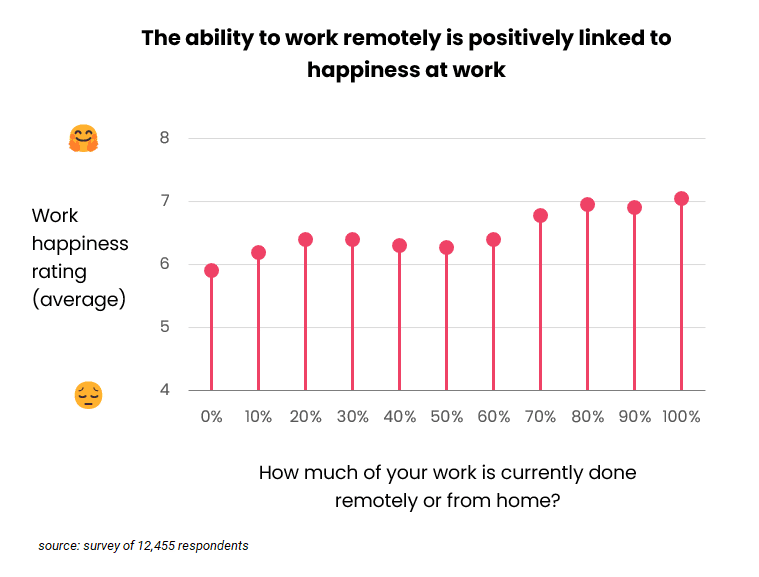
The average work happiness of people who have to come into the office 100% of their time is 5.90. In contrast, employee happiness is at a 7.04 for those who spent 100% of their time working remotely. This is an increase of 20%.
Employee happiness increases as much as 20% by offering the ability to work 100% remotely.
Interestingly, we found that average employee happiness increases by 3% for every added remote workday.
Millennials are happiest when working remotely
We asked our 12,455 respondents about the generation that they belong in:
- Which generation are you part of?
Our data shows that – on average – younger generations are more likely to work remotely.

We found that the happiness of Millennials increased the most as a result of working remotely.

For example, when Millennials are given the ability to work an extra full day remotely, their happiness at work increases by 4% on average.
Happiness at work increases the most for Millennials when given the ability to work remotely.
Interestingly, happiness at work is highest for the youngest and oldest generations in the work field.
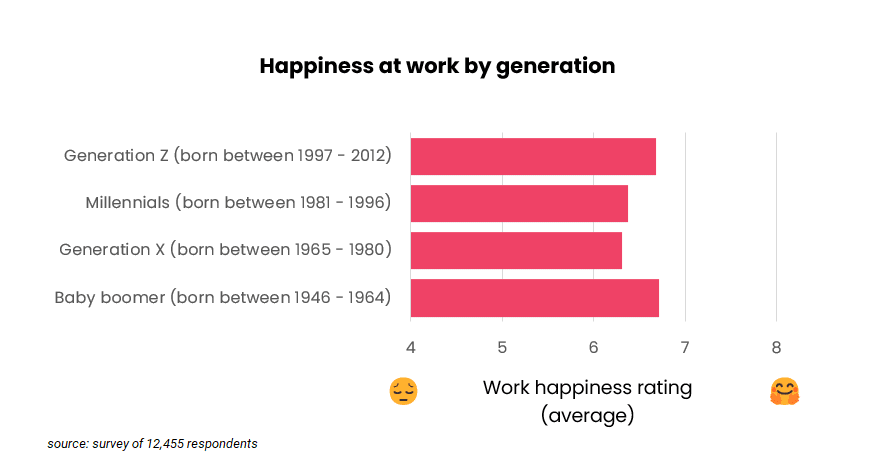
This finding can be explained by the well-researched U-curve in happiness.
In general, happiness decreases from age 18 and reaches peak unhappiness at approximately age 47. From there, the happiness levels gradually increase again. This principle may apply to happiness at work too, which explains the lower happiness for the middle-aged generations.
If you’re struggling with happiness at work, we’ve published 12 tips on how to be happier at work that might be helpful for you! Or if you’re still on the lookout for your next job, here are 11 tips to help you find a job that makes you happy.
Returning to office-based work after the pandemic reduces employee happiness
During the pandemic, many companies offered their employees the ability to work 100% remotely.
We asked our respondents how much they got to work remotely during the peak of the pandemic.
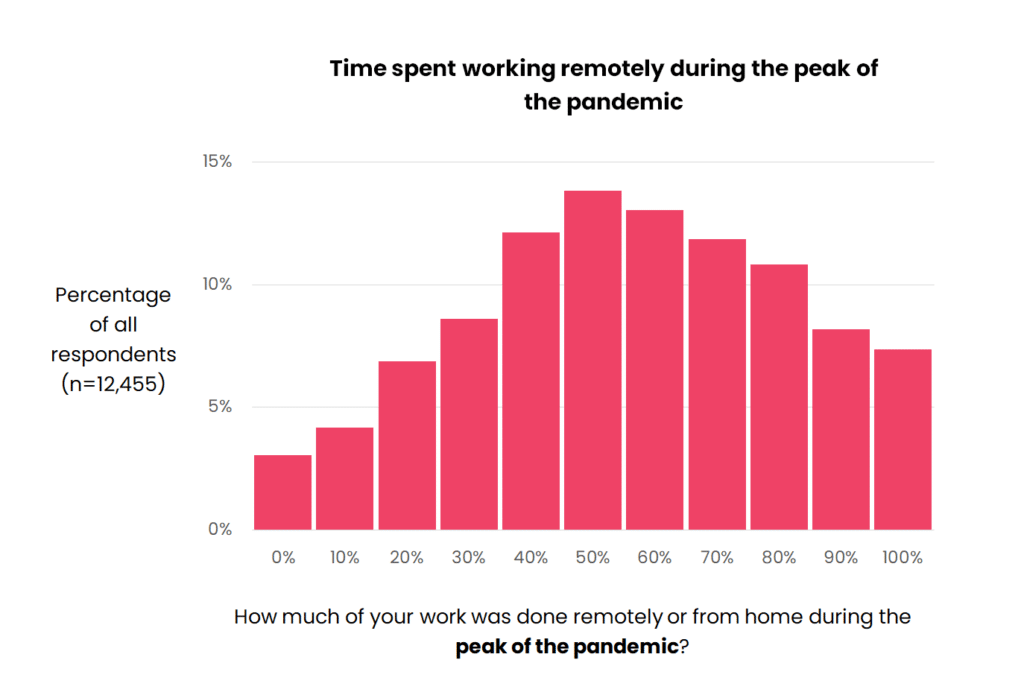
On average, our respondents spent 56% of their time working remotely during the peak of the pandemic.
Since the peak of the pandemic, some companies have returned “back to normal” by herding employees back to the office. We wanted to find out how much a return to the office affects employee happiness.
We found that employees who were stripped of the ability to work remotely were relatively unhappy at work.
Respondents that had the ability to work 100% remotely at the peak of the pandemic, but are now mandated back to the office 100% of the time are significantly unhappier than the average respondent.

What this data shows is that employee happiness is likely to decrease as a result of “back-to-office” mandates.
This chart only focuses on the respondents that had a reduction in remote working hours. Some respondents have gone up in their remote working hours since the peak of the pandemic, but the sample size is too small for these respondents to make any observations.
Employee happiness decreases as commute times increase
We asked our respondents how long they typically commute to their work.
This resulted in the following answers:
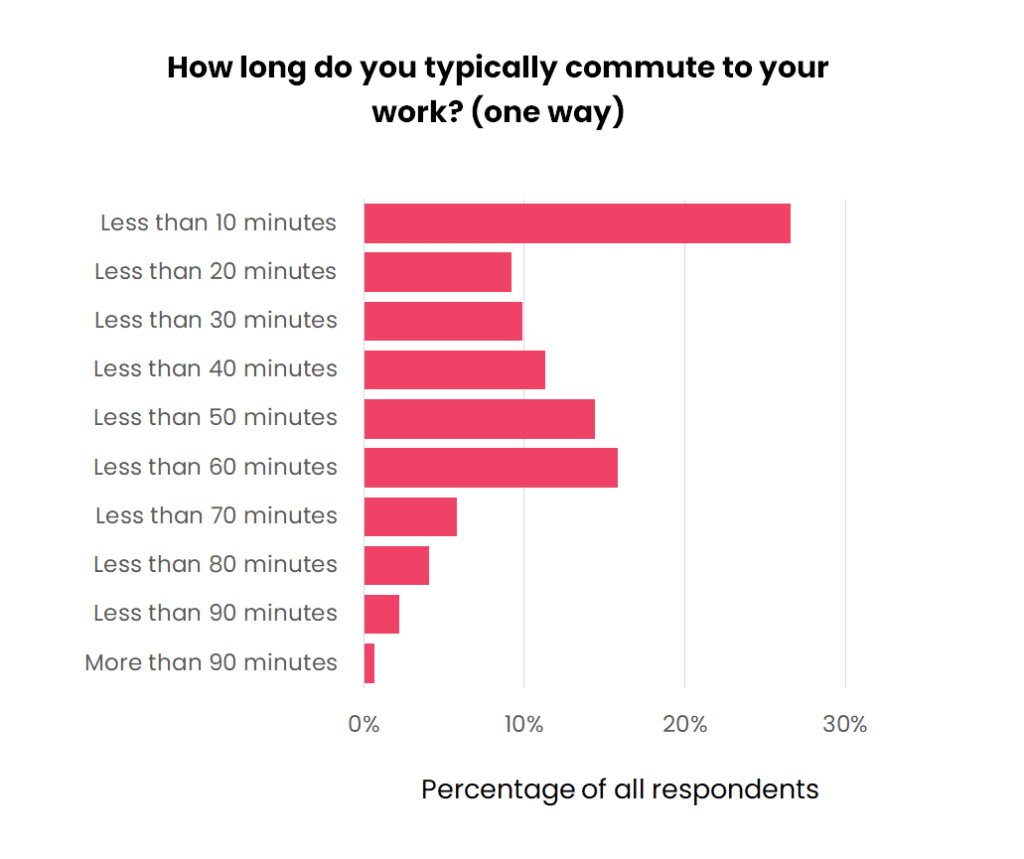
The median respondent of our survey travels less than 40 minutes to the office (one way).
We compared commute times with average employee happiness scores and found a negative correlation.

Our data shows that employee happiness decreases as commute times increase.
Average happiness scores at work are relatively stable up to a commute time of 60 minutes. Work happiness sharply declines as commute times increase beyond one hour.
Happiness at work is significantly correlated to overall life happiness
At the start of our survey, we asked our respondents about their general happiness levels.
- If you look back at the last year of your life, how would you rate your happiness on a scale from 1 to 10?
With this data, we could compare work happiness to overall life happiness for each respondent.
We created this correlation heatmap that shows each respondent on an X and Y-axis.
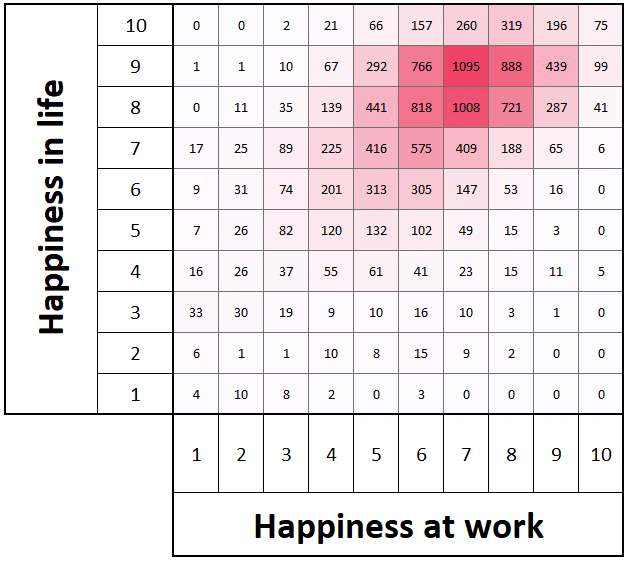
How to read this heatmap (click to expand)
The intersection of the X and Y-axis shows the number of respondents. For example, in the lower left, 4 respondents answered that both their happiness at work and happiness in life was a 1 out of 10. The reddest cell shows that 1,095 rated their happiness at work as a 7 and their happiness in life as a 9.
The correlation between happiness at work and happiness in life is significant, with a coefficient of determination (or R2) of 0.27. In other words, 27% of someone’s life happiness can be explained by someone’s happiness at work. Interestingly, the value of this correlation did not fluctuate significantly between generations.
Commentary from the team:

Hugo Huijer, Founder of Tracking Happiness
Our study shows that employees that have the ability to work from home are happier than those that don’t. On top of this finding, we saw a strong negative correlation between commute times and employee happiness.
In that sense, companies can improve employee happiness by simply allowing them to work from home more. Not only does this benefit the environmental footprint of your company, it also helps improve employee morale.
On top of that, studies have proven again and again that employee happiness is linked to productivity and job performance.
Having your employees work from an office might make sense in the short term. But if it results in employee unhappiness, it can result in a drop in sustainability and performance that can be far more severe than an empty office building.
Methodology
Our survey consists of 12,455 respondents spread across the world. 65.1% of respondents were male, whereas 34.5% were female.
The location of respondents varied, with 38.6% coming from North America, 36.1% coming from Asia, 19.5% coming from South America, and 5.1% coming from Europe.
Survey responses were collected between April 10, 2022 and April 17, 2022.
Responses were collected through Amazon Mechanical Turk (MTurk). MTurk is a “crowdsourcing” platform where “workers” complete tasks for a paid compensation. Survey respondents were only allowed to respond once.
Illegitimate responses such as duplicate responses or responses with missing data were filtered from the results. The survey responses were completely anonymized. No personal names or email addresses were collected.
Closing words
If you’re a leader of a company, what’s keeping you from giving your employees the ability to work remotely? And if you’re an employee, how do you feel about our results?
While some companies embrace a remote work environment, there are some that value the benefits of a shared office space. In the end, we hope our study helps shed light on how much the ability to work from home impacts employee happiness.
What’s your main takeaway from today’s study? Do you have a question about something from our analysis? Leave a comment below to let us know.
Fair use and redistribution
Tracking Happiness grants you permission to reuse, host, or repost the graphics and images from this article. When doing so, we ask that you kindly attribute the authors by linking to Tracking Happiness or this page.


What is the date when this study was published on this page?
April 25th of 2022.